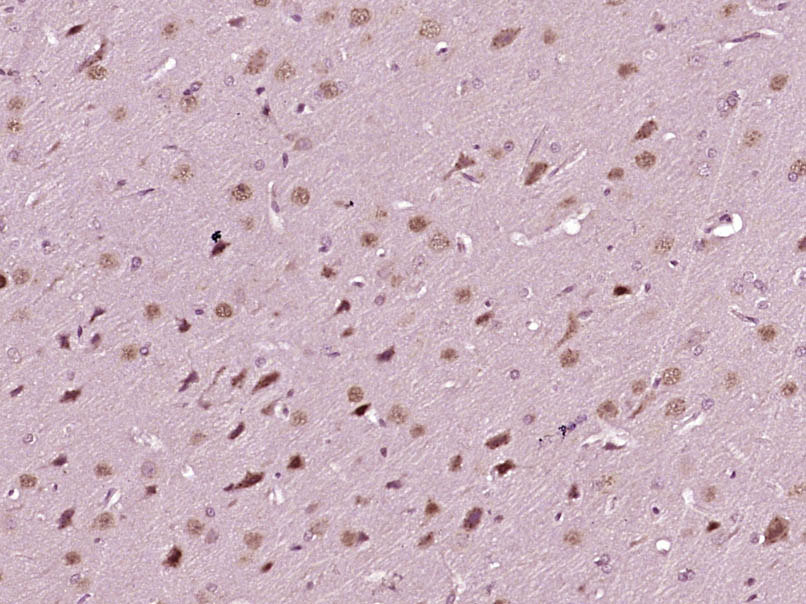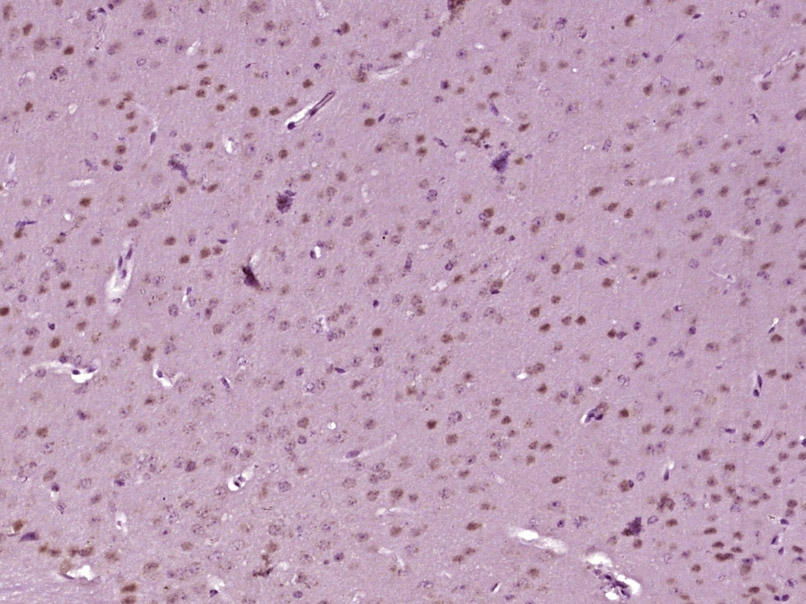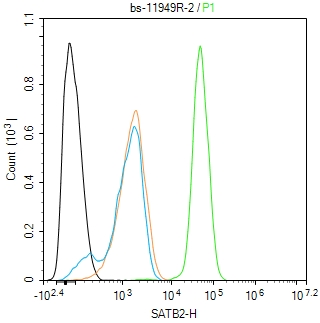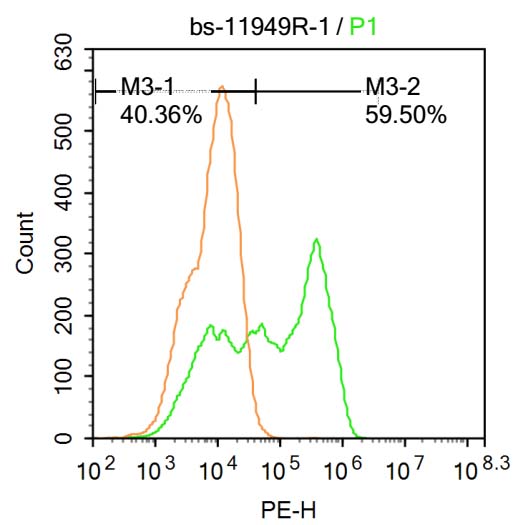
Rabbit Anti-SATB2 antibody
DNA binding protein SATB2; DNA-binding protein SATB2; FLJ21474; FLJ32076; KIAA1034; MGC119474; MGC119477; SATB family member 2; SATB homeobox 2; SATB2; SATB2_HUMAN; Special AT rich sequence binding protein 2; Special AT-rich sequence-binding protein 2.
View History [Clear]
Details
Product Name SATB2 Chinese Name DNABinding protein2抗体 Alias DNA binding protein SATB2; DNA-binding protein SATB2; FLJ21474; FLJ32076; KIAA1034; MGC119474; MGC119477; SATB family member 2; SATB homeobox 2; SATB2; SATB2_HUMAN; Special AT rich sequence binding protein 2; Special AT-rich sequence-binding protein 2. literatures Research Area Developmental biology Neurobiology Signal transduction Binding protein Immunogen Species Rabbit Clonality Polyclonal React Species Human, Mouse, Rat, (predicted: Cow, Horse, Sheep, ) Applications WB=1:500-2000 ELISA=1:5000-10000 IHC-P=1:100-500 IHC-F=1:100-500 Flow-Cyt=2ug/test ICC=1:100-500 IF=1:100-500 (Paraffin sections need antigen repair)
not yet tested in other applications.
optimal dilutions/concentrations should be determined by the end user.Theoretical molecular weight 83kDa Cellular localization The nucleus Form Liquid Concentration 1mg/ml immunogen KLH conjugated synthetic peptide derived from human SATB2: 451-485/733 Lsotype IgG Purification affinity purified by Protein A Buffer Solution 0.01M TBS(pH7.4) with 1% BSA, 0.03% Proclin300 and 50% Glycerol. Storage Shipped at 4℃. Store at -20 °C for one year. Avoid repeated freeze/thaw cycles. Attention This product as supplied is intended for research use only, not for use in human, therapeutic or diagnostic applications. PubMed PubMed Product Detail SATB2 is a nuclear matrix protein that influences craniofacial formation mechanisms, such as jaw and palate development, and is part of a transcriptional network regulating skeletal development and osteoblast differentiation. Highly expressed in adult and fetal brain, SATB2 contains two CUT DNA-binding domains and one homeobox domain and is closely related to SATB1, a transcriptional repressor. SATB2 is thought to bind to matrix-attachment regions (MARs) and regulate MAR-dependent transcription of various genes, including HoxA2 and ATF4 (CREB-2), involved in skeletal development. Functioning as both a transcriptional activator and repressor, SATB2 can also act as a protein scaffold that can enhance the activity of other DNA-binding proteins. Defects in the gene encoding SATB2 are the cause of cleft palate manifested in conjunction with severe mental retardation.
Function:
Binds to DNA, at nuclear matrix- or scaffold-associated regions. Thought to recognize the sugar-phosphate structure of double-stranded DNA. Transcription factor controlling nuclear gene expression, by binding to matrix attachment regions (MARs) of DNA and inducing a local chromatin-loop remodeling. Acts as a docking site for several chromatin remodeling enzymes and also by recruiting corepressors (HDACs) or coactivators (HATs) directly to promoters and enhancers. Required for the initiation of the upper-layer neurons (UL1) specific genetic program and for the inactivation of deep-layer neurons (DL) and UL2 specific genes, probably by modulating BCL11B expression. Repressor of Ctip2 and regulatory determinant of corticocortical connections in the developing cerebral cortex. May play an important role in palate formation. Acts as a molecular node in a transcriptional network regulating skeletal development and osteoblast differentiation.
Subunit:
Interacts with ATF4 and RUNX2; resulting in enhanced DNA binding and transactivation by these transcription factors (By similarity). Interacts with PIAS1.
Subcellular Location:
Nucleus matrix.
Tissue Specificity:
High expression in adult brain, moderate expression in fetal brain, and weak expression in adult liver, kidney, and spinal cord and in select brain regions, including amygdala, corpus callosum, caudate nucleus, and hippocampus.
Post-translational modifications:
Sumoylated by PIAS1. Sumoylation promotes nuclear localization, but represses transcription factor activity.
DISEASE:
Note=Chromosomal aberrations involving SATB2 are found in isolated cleft palate. Translocation t(2;7); translocation t(2;11). Defects in SATB2 are a cause of cleft palate isolated (CPI) [MIM:119540]. A congenital fissure of the soft and/or hard palate, due to faulty fusion. Isolated cleft palate is not associated with cleft lips. Some patients may manifest other craniofacial dysmorphic features, mental retardation, and osteoporosis. Note=A chromosomal aberration involving SATB2 is found in a patient with classical features of Toriello-Carey syndrome. Translocation t(2;14)(q33;q22).
Similarity:
Belongs to the CUT homeobox family.
Contains 2 CUT DNA-binding domains.
Contains 1 homeobox DNA-binding domain.
SWISS:
Q9UPW6
Gene ID:
23314
Database links:Entrez Gene: 23314 Human
Entrez Gene: 212712 Mouse
Omim: 608148 Human
SwissProt: Q3ZB87 Human
SwissProt: Q4V763 Human
SwissProt: Q9UPW6 Human
SwissProt: Q546B3 Mouse
SwissProt: Q8VI24 Mouse
Unigene: 516617 Human
Unigene: 145599 Mouse
Unigene: 216103 Rat
Product Picture
Primary Antibody (green line): Rabbit Anti-SATB2 antibody (SL11949R)
Dilution:2ug/Test;
Secondary Antibody(white blue line): Goat anti-rabbit IgG-AF488
Dilution: 0.5ug/Test.
Isotype control(orange line): Normal Rabbit IgG
Protocol
The cells were fixed with 4% PFA (10min at room temperature)and then permeabilized with 90% ice-cold methanol for 20 min at -20℃, The cells were then incubated in 5%BSA to block non-specific protein-protein interactions for 30 min at room temperature .Cells stained with Primary Antibody for 30 min at room temperature. The secondary antibody used for 40 min at room temperature. Acquisition of 20,000 events was performed.U-937 cells were fixed with 4% PFA for 10min at room temperature,permeabilized with 90% ice-cold methanol for 20 min at room temperature,and incubated in 5% BSA blocking buffer for 30 min at room temperature. Cells were then stained with SATB2 Antibody(SL11949R) at 1:100 dilution in blocking buffer and incubated for 30 min at room temperature, washed twice with 2%BSA in PBS, followed by secondary antibody incubation for 40 min at room temperature. Acquisitions of 20,000 events were performed.Cells stained with primary antibody (green), and isotype control (orange).
Partial purchase records(bought amounts latest0)
No one bought this product
User Comment(Total0User Comment Num)
- No comment






 +86 571 56623320
+86 571 56623320




